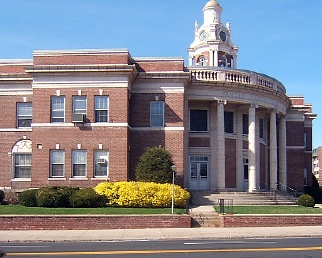 |
|
June 6, 2007
Senate to DEP:
Finish that Newhall Plan, Already!

File photo
By Sharon Bass
As the state continues to drag its bureaucratic feet in producing a final plan for the Newhall remediation project, the state Senate decided yesterday it should be a law. It approved a bill that will force the Department of Environmental Protection to finalize a cleanup plan within 90 days of the bill’s passage. It still has to go through the House and full Legislature.
According to a press release issued yesterday from the Senate Democrats: “Senator Majority Leader Martin M. Looney (D-New Haven) and Senator Joseph Crisco (D-Woodbridge) have successfully gained Senate approval of an amended bill that is designed to speed up relief for residents in the Newhall neighborhood in Hamden where a number of homes were damaged because they were constructed on contaminated soil. The problem was identified nearly seven years ago when contaminates were discovered in the soil during a renovation project at the Hamden Middle School.”
Dennis Schain, spokesman for the DEP, said he didn’t know when the long-awaited plan would be ready. The department unveiled a remediation proposal on Aug. 17, 2006, at Southern Connecticut State University to a very displeased crowd. On Aug. 31, the Newhall Advisory Committee turned it down. Since then, the state has solicited input from residents on what they kind of cleanup they want.
“Yes, it is taking some time but there are many complex issues involved and we are attempting to be as responsive as possible to issues and concerns,” said Schain.
In response to how the final plan will differ from the one shot down last August he said, “We hope to try and address concerns that were raised as best we can."
But will it be different? “We’re not ready to release the plan or the details at this point,” he said.
The June 5 release goes on to say: “The legislation requires the commissioner of the Department of Environmental Protection (DEP) to adopt a final plan and implement a timetable for the remediation of public and private properties in the Newhall neighborhood, ninety days after the laws takes effect, which is immediately upon passage. The commissioner must base the plan on the remediation alternatives developed by the Newhall Advisory Committee ...”
Therein lies the fight between the DEP and the residents of Newhall. The state’s plan called for removing the top 4 feet of soil from contaminated properties and replacing it with clean topsoil. If the contamination runs deeper, that property would be slapped with a land-use restriction -- the kiss of death for property value, according to many.
NAC’s proposal was for all contaminated dirt to be removed -- no matter how far down, to prevent the land restrictions -- and carted out of town. The state initially wanted to dump it behind the old middle school. Both the state’s and community’s plans included knocking down and replacing homes that are severely structurally damaged due to the shifting landfill below.
And there was Yale professor Keith Darden’s plan.
His house, which is outside the Newhall consent order boundary, was tagged contaminated in December 2005 and he sprung into action. He successfully fought the state last December in removing his and other houses in Prospect Hill -- which were built on top of a farm, not a toxic landfill -- from the contaminated list. Darden maintained that the DEP uses too strict lead-soil standards, and many of the 300-plus houses targeted for remediation don’t need it. He questioned the motive of the no-bid contractor DEP hired to do the soil testing and the millions of dollars it was paid.
And bottom line, Darden said there are no health risks. According to the state Department of Public Health, there are no studies or documented proof that people have become ill because they live atop the former Winchester Gun and residential dump.
“I think any plan that they present would have to be realistic to get the support of the Legislature,” said Darden. “So this will get resolved either by a good plan or by a lack of Legislative support, which would mean keeping the status quo. I think everybody recognizes that the status quo doesn’t present a significant health risk.”
Schain said the department will not use the more liberal lead-soil standard set by the Environmental Protection Agency that Darden has proposed using, which would eliminate many homes from the contaminated-property list.
The Senate bill mirrors NAC's action plan. According to the release: “The measure also calls for the plan to include the removal of all contaminated soil and dispose of it at a facility licensed for such purpose, to restore the neighborhood without land use restrictions, and to immediately purchase those homes suffering severe structural damage and safely relocate the occupants while giving them the option to return.”
In the 2003 consent order, the state and Olin Corporation (which absorbed Winchester) are to evenly split the cost of cleaning the residential properties. Schain said the project is estimated at $80 million. It would be the largest residential remediation in the state.
That means the Legislature has to allocate $40 million in the 2007-09 budget, which lawmakers are actively squabbling over. Schain said Gov. Rell proposed $35 million for the state Superfund account in her two-year budget, much of it intended for the Newhall remediation. That marked a sharp hike of about $30 million over current funding.
“Not every penny but the increase is largely intended for Hamden,” he said. It’s unclear how much will wind up in the new state tab for taxpayers. It’s also unclear if Olin will cough up the $40 million.
“The amount being discussed in her [Rell’s] budget was significant to move us along,” said Schain. “The Democratic budget may be more of a moving target.”
“There have been enough remedial investigations and feasibility studies about the damaged homes in the Newhall section of Hamden because of this contamination problem,” Crisco was quoted in the press release. “The residents have waited long enough for assistance. This bill is designed to expedite a remediation plan and provide relief for the homeowners.”
March 19, 2007
A Great Day For a Sled
From the lens of Betsy Driebeek's camera on St. Patty's Day
Michael Stone of Hamden and his five-year-old daughter,
Madeline, add color to the white landscape at Brooksvale Park.
About to go down. Hamden buddies (left to right) Jeffrey Grant, Cody Seasterand and Tom Sullivan with Grant's mother, Linda, at far fight on a Paradise Avenue hill.
Rich Hart of Hamden pulls his daughters Emma, 4, and Megan, 3, around Brooksvale Park on their toboggans.
The Grant group on its way back up the Paradise Avenue hill.
March 5, 2007
By Sharon Bass
It’s still unclear when the state will disclose its final remediation plan for the Newhall neighborhood. The one it presented last summer residents resoundingly turned down, and the project itself has been at the center of emotional and scientific controversy.However, it might be a little clearer where the dough will come from. In Gov. Jodi Rell’s proposed ’07-’09 budget, there is a $35 million bond item for Superfund (contaminated) sites. The Department of Environmental Protection says most of that money will go into cleaning up the polluted soil and rehabbing and replacing homes that have been badly bruised by the shifting old landfill beneath them, in Newhall.
“A large majority of these funds would be earmarked for the Newhall cleanup, that is the intent of this recommendation,” said DEP’s Dennis Schain. The Legislature approves the final budget.
He said the governor and the DEP know more money will be needed to meet the state’s responsibility of $30 million to $40 million of the total tab. That figure represents half the cost of the residential portion of the cleanup, with Olin Corporation picking up the other half. A 2003 consent decree named Olin, the state, the town of Hamden and the Regional Water Authority responsible for funding what would be Connecticut’s largest residential remediation. The old middle school and the two parks are also included in the cleanup.
“We do know, however, that this represents a strong commitment to this project and that it will provide funding for the initial steps required,” said Schain.
Asked where additional funding might come from, he said, “We will work closely with the administration to make sure this funding vehicle remains available -- and in a timely fashion -- for any additional dollars needed.”
Schain said the DEP is not rushing the final product. The department, he said, is currently devoting a “great deal of time to assessing public comments and alternative plans submitted. We received suggestions and recommendations worthy of serious review and consideration as we move toward a final plan.
“Once the final plan is released and funding is secured, this project will be ready to move forward.”March 2, 2007
By Peter Haller
"There is a fascinating story of coming full-circle imbedded in the 100th anniversary of the Whitneyville Civic Association which is being celebrated during 2007. The story of Whitneyville is in many regards the story of Hamden itself, as it was transformed from rural town to 'first-ring' suburban city at the turn of the 20th century. While the physical setting has changed, the 'new' families of the middle class who filled the freshly-opened housing subdivisions beginning in 1907, were not that different from the families that today call Whitneyville home. They were from the managerial class with young families and moved from the city to find that piece of the dream. Common to yesterday and today, they came then and still arrive for the natural setting, pleasant streetscapes, modest but distinct houses, a sense of strong community and the close location to the urban bustle of New Haven.
"At the turn of the 20th century, Whitneyville and the landscape which today is filled with residential neighborhoods and a commercial village center was farmland, orchards and scattered houses. The population was less than 300 people and its lifeblood stemmed from the lakes and the nearby industry the Mill River had fostered. Community life was centered around the Whitneyville parish of our landmark church, a small brick schoolhouse and a rural setting and pace hard to imagine today.
Whitneyville Congregational Church.
"As American cities expanded outward, Whitneyville was positioned to absorb the growing need for housing and industry. Located along the 'turnpike road', its plenty of land and among its residents, key 'movers and shakers', who saw the future and transformed the landscape into a new suburban ideal for family living. The Whitneyville Civic Improvement Association came into being in 1907 under the leadership of businessmen such as Henry W. Munson, T. Whitney Blake, Morris Steinert and Frederick Graves.
"As in many of the expanding metropolitan areas, technology would transform where we lived and how we lived. Electrical utility companies would soon replace the 19th century gas lighting along the streets, introduce the common use of electric lighting in our houses and power trolleys at the dependable rate of over five miles an hour.
"Transportation and cheap land began the story. Beginning in the 1896, The Connecticut Company, in partnership with electric utilities, petitioned the Town of Hamden to allow electrification of the Whitney Avenue line. This dramatic improvement in transportation allowed workers to reach the factories and businesses in downtown New Haven. The accessibility of cheap land led to speculation in Whitneyville, and several family farms passed from father to son, opening hundreds of house lots.
"Over the following decade, the Whitneyville Civic Improvement Association would spearhead petitioning the Town Selectmen for electrified trolleys, telephone service, street lighting, sewers, roads and bridges and new school buildings.
The Cedars.
"By 1917, individuals among the leadership of the WCIA were instrumental in the formation of the Hamden Civic Association, a town-wide group which spread the call for improved city planning in all of the new neighborhoods booming throughout the town. With the outbreak of World War I, as with many civic groups, the WCIA organization turned its attention to the war effort and fell into a slumber. Bridges and roads standards were written into state laws and economic aid came from the state to deal with the impacts of growth and the automobile. Throughout the 1920 and 30’s, housing was built at a rapid pace filling today’s neighborhoods such as 'The Cedars' (bounded by Putnam, Mather, Whitney and Clifford) and the Blake Road and Augur Street areas. In 1924 the Town created a Planning Board and passed new zoning, building and plumbing codes and began to staff these key positions within the government, fundamentally changing the role of our organization from pioneering, front-line advocacy to partners with local government.
"After World War II, as local governments grew and many of the former roles played by civic organizations were codified as public responsibilities, civic energy reappeared in the form of three different organizations; the Whitneyville Community Club, the Whitneyville Ladies Club and the Whitneyville Garden Club. In the 1940’s and 50’s many social connections like dances, plays and special speakers brought folks together.
The Eli Whitney Barn.
"Today, we know the successor organization as the Whitneyville Civic Association. Our mission includes preserving the character and sense of place built during these earlier days. Dozens of WCA volunteers are involved a diverse range of activities all aimed at bettering the quality of life for neighborhood residents. Recent accomplishments have included nominating a historic district, re-building streetscape in the commercial area, planting new trees and improving open spaces and parks, lobbying for a strong local library and pressing for long overdue re-investment in the decaying street infrastructure.
"Most importantly, what develops from our collective energy within the Whitneyville Civic Association is an essential sense of community and mutual responsibility for carrying on the heritage of the past century. We are a diverse neighborhood with an incredible array of talents and interests. Just as the group who came together in 1907, to realize the challenges of the next century, we will need energy, persistence and vision. This year, as we celebrate one hundred years of community action, the Whitneyville Civic Association looks forward to building membership and outreach so that our collective voice remains strong in the interest of preserving the social and physical heritage of our truly special Hamden neighborhood.
"On behalf of all the members and active neighbors of Whitneyville, I invite all who call our village home to become engaged and stay informed by attending our regularly-scheduled meetings, using our website at www.whitneyville.org and by finding your spot on one of our committees. The next meeting is Wednesday, March 14th at 7:00 pm at the BOE building at 60 Putnam Avenue. Good work, everyone! Happy 100th!"
Peter Haller is president of the Whitneyville Civic Association.
February 19, 2007
One Man's Crusade Continues

Darden speaking out against the state's cleanup plan last summer. File photo
By Sharon Bass
Keith Darden continues to fight a community -- and may just win. First, he argued that his neck of the woods, Prospect Hill -- just outside the 2003 Newhall consent order -- did not need the expensive cleanup the state insisted it did. After reviewing its findings upon pressure from Darden, the Department of Environmental Protection reversed its decision last December and gave Darden’s and his neighbors' yards a clean bill of health.
Now he’s got a state senator listening to his claim that Connecticut’s lead-soil standard is too strict and is dictating an unnecessarily widespread, costly ($200 million or more) and unprecedented residential remediation of Hamden's Newhall section, once an industrial/residential dump. Darden believes the federal standards are safe while residents who are pushing for a complete cleanup of their neighborhood say pooh-pooh.
But Sen. Joe Crisco (D-17) isn’t pooh-poohing. He's heard the Yale professor’s arguments about replacing the state lead-soil threshold of 400 parts per million with the federal standard of 1,200 parts, and has submitted legislation that would do just that.
His bill reads: "To amend the general statutes to require lead soil levels for residential real property not be greater than 1200 mg/kg, consistent with standards set by the United States Environmental Protection Agency."
According to Darden, the Newhall remediation project would be considerably scaled back under the fed’s guidelines. He figured that just 10 percent of the 300-plus properties tagged by the DEP would need to be remediated, by having 4 or more feet of soil carted out of town and replaced with clean topsoil. He said the state has “artificially” high standards. According to the Department of Public Health, there have been no known health consequences from people living atop the dump.
“This is what is wonderful about the process. You learn what the concerns are and the remarkable thing is you have people who are not involved in government who have knowledge,” said Crisco. “We depend on people like Keith to keep us up to date on issues we might not have knowledge of.”
“I genuinely think this is the most positive step I’ve seen in Newhall,” said Darden. “I think this is a milestone. I think it will prevent future Newhalls.”
The Legislature’s Environment Committee will look at Crisco’s bill and decide whether to hold a public hearing on it, the state senator said. If it passes committee, it would go to the Senate.
“I have no problem with us having stricter standards but sometimes you have to have balance and be reasonable,” said Crisco. “Basically we’re looking for information to make the right decision. I’m not an expert on this. I want what’s best for the residents.”
Darden, a member of the Newhall Advisory Committee, has sustained much opposition from many who live in the Newhall consent order. Leaders such as Adbul Hamid insist on a complete cleanup of all properties and residents compensated for their "emotional suffering."
“The main issue from many NAC members is they don’t want to be treated differently because it’s a working-class, mostly nonwhite neighborhood. They fear they’ll be treated worse,” said Darden. “It’s quite clear there’s going to have to be some change. The EPA only recently came out with this lead standard and it comes off on the back of a huge amount of research.”
January 23, 2007
Whose Town is it Anyway?


Town-gown committee members Bob Westervelt, Mike Germano, Matt Fitch. File photos
By Sharon Bass
Much of the anger and bitterness lingers, but those who live among university students are beginning to take the next step: acceptance. Beginning to.
In response to an avalanche of neighborhood complaints about the ill behavior of some students who live on their streets, committee Chair Mike Germano told folks that Quinnipiac is building enough dorms to ensure every undergrad student a bed.
“They finally listened to the students,” said Germano. There are currently no dorms for seniors and Germano, a recent Quinnipiac graduate, said seniors don’t want to move off campus.
“If anything, we should be thrilled the students are going to be out of the greater neighborhood,” said association member Peter Schwartz. “Is there going to be more traffic? Of course.”
Residents' focus has now somewhat shifted to what will happen to northern Whitney Avenue -- where many student houses are located -- once the dorms are up. What will their end of town look like?
Homes in good shape would likely be sold to families, possibly placing a burden on the school system and other municipal services, said committee member Matt Fitch. But other houses are in “terrible shape,” he said, and would probably be razed and become retail and commercial spaces, putting much-needed tax dollars into the municipal coffers. (Quinnipiac-owned student houses are not taxed; those owned by private investors are.)
“We know in 10 years it’s going to look very different,” said Fitch. “Like it or not, Whitney is going to become more commercial. We want to make sure it’s done right. We definitely have to have a plan of our own.”
“We have to be proactive,” said Bob Westervelt, the third member of the town-gown committee, urging people to show up at land-use commission meetings when development plans are being discussed. “It does no good to go to your council people and state reps after plans are passed.”
State Rep. Brendan Sharkey (D-Hamden) was in the audience of about 35 at Mt. Carmel Congregational Church. He, too, stressed that people should take the reins in deciding the future of northern Hamden.
“We tend to react more to Quinnipiac's plans,” said Sharkey. “And their plans seem to be off the cuff.”
“It’s [the committee’s] job to make sure Quinnipiac is doing everything they’re saying,” said Germano.
Dobie talked about the impact of the university’s new York Hill Campus, where the TD Banknorth sports complex is. Graduate classroom buildings were to be built there, but last week the university made an unexpected announcement that it bought the Anthem North Haven site to house most graduate programs. (Dobie said the project would take 10 years to complete.)
That led Schwartz and others to question whether the school would increase its undergrad enrollment, which would mean more traffic on the already-congested Whitney Avenue.
Dobie said Quinnipiac officials have told him “more than once” that won’t happen. “But I tell you I wouldn’t put a nickel on it at this point,” he said.
Folks also didn't like that the school applied for a liquor license for the so-called presidential section of the sports complex for VIP types. Liquor would not be sold anywhere else, said Dobie.
“Do we as a town have the right to say no to booze?” asked Schwartz.
“Anyone has the right to respond to the [liquor application],” said Sharkey.
“It is true that Quinnipiac is acting more responsibly,” said Fitch, attributing that to “the progress the new administration” has made with university officials.
Ethical Development
The town-gown threesome brought another piece of news. An ethics ordinance is being drafted by Town Planner Leslie Creane and Planning & Zoning Chair Joe McDonagh, both of whom attended Monday evening’s meeting.
Fitch explained.
Under the proposal, commission members and elected officials who work for or have another business relationship with an applicant -- private developers such as Quinnipiac -- would have to recuse themselves from discussing and voting on those projects. Those who violate the local law could be removed from office.
“This is not revolutionary stuff,” said Fitch. “This is stuff that should be self-evident but spelled out.” He said the proposed ordinance should be on the Jan. 29 Legislative Council committees agenda, and the following Monday public input will be heard and a vote would likely be taken.
Site designed by Joanne Kittredge

Tip Us Off
Send
news tips







